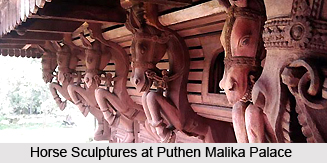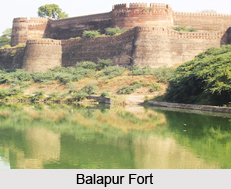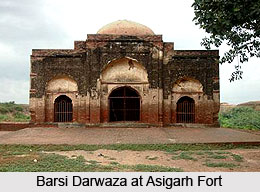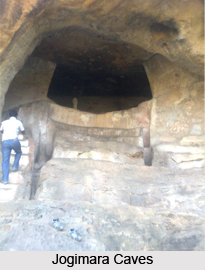 Collections in Puthen Malika Palace comprise a number of intriguing artefacts and royal belongings of Travancore family. Puthen Malika Palace, also known as Kuthira Malika, is a majestic wooden palace standing in Thiruvananthapuram, Kerala, on the south eastern side of Padmanabha Swamy temple. Constructed by Swathi Thirunal, the southern wall of the palace has 108 horse figures. This feature of the palace has rendered it the name `the Palace of the Horses`. Beautiful stone and wooden pillars adorn the palace along with smooth black flooring. The intricate wooden carvings, sculptures and exquisite architecture of Puthen Malika Palace have been preserved beautifully till date. Swathi Thirunal had dwelled in the palace prior to his death and it is believed that Swathi Thirunal had drafted some of his significant compositions in the palace.
Collections in Puthen Malika Palace comprise a number of intriguing artefacts and royal belongings of Travancore family. Puthen Malika Palace, also known as Kuthira Malika, is a majestic wooden palace standing in Thiruvananthapuram, Kerala, on the south eastern side of Padmanabha Swamy temple. Constructed by Swathi Thirunal, the southern wall of the palace has 108 horse figures. This feature of the palace has rendered it the name `the Palace of the Horses`. Beautiful stone and wooden pillars adorn the palace along with smooth black flooring. The intricate wooden carvings, sculptures and exquisite architecture of Puthen Malika Palace have been preserved beautifully till date. Swathi Thirunal had dwelled in the palace prior to his death and it is believed that Swathi Thirunal had drafted some of his significant compositions in the palace.
Artefacts of Puthen Malika Palace
A part of Puthen Malika Palace has been converted to a Palace Museum which hosts several valuable possessions of Travancore royal family. Out of 80, only 20 rooms have been opened for the visitors. Visitors can cherish a guided tour in the museum and witness its exquisite collections. Musical instruments, armaments, Belgian harpoon, paintings, crystal chandeliers, Italian and Belgium mirrors, traditional furniture, 14 life-size Kathakali mannequins, a musical tree producing 8 sounds when tapped and many others form the interesting artefacts of Puthen Malika Palace. Ivory cradles of different sizes can be witnessed on the right side of the mannequins.
Two royal thrones have also been displayed in the museum. One of the thrones is made of Bohemian crystal adorned with Tranvancore emblem `conch` on the top of the backrest while the other one is structured with 24 elephant tusks known as Dantasimhasana. An array of magnificent sculptures and idols made of white marble are also housed in the museum. There are rooms on the first floor of the Puthen Malika Palace which were once used as the library and audience chamber. There was also an alcove where Swathi Thirunal used to meditate and had composed some of his most famed musical compositions. A direct view of Padmanabhaswamy temple can be enjoyed from this room. Wonderful carvings of dragon, elephant and peacock can be seen on a small wooden stair nearby. Ceiling of the rooms are richly embellished with paintings of elephant, peacock and parrot. An illustrious portrait of Sree Chithira Thirunal Balarama Varma made by Svetoslav Roerich has been showcased in one of the rooms. The unique feature about the portrait is that the face and shoes of the king seems to face the onlooker from any point of the room.
Swathi Sangeethotsavam
Swathi Sangeethotsavam is an annual music festival held in the courtyard of Puthen Malika Palace. The event is organized to celebrate the legacy of Swathi Thirunal. Conducted every year from 6th to 12th January, the event attracts connoisseurs of Hindustani and Carnatic music.




